Sudoku.com - Classic Sudoku - Logic puzzles & challenges
Challenge your brain with hundreds of classic Sudoku puzzles.
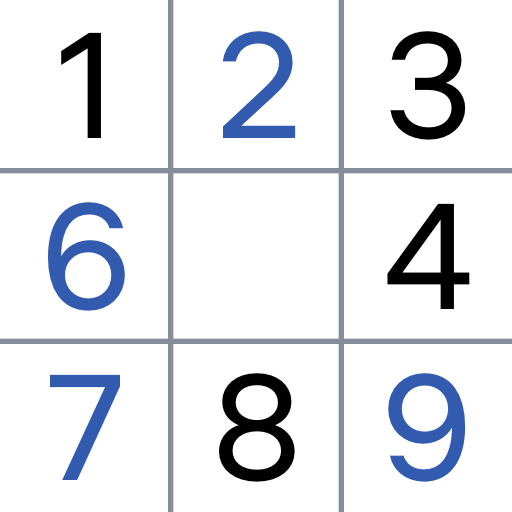
- 6.14.0 Version
- 4.1 Score
- 46M+ Downloads
- In-game purchases License
- 3+ Content Rating
Get ready to challenge your brain with Sudoku Free Puzzle, a popular classic number game designed to keep you sharp. With thousands of puzzles to solve, this app is perfect for beginners and advanced players alike. Whether you want to relax or give your brain a workout, Sudoku Free Puzzle has you covered.
3 Reasons to Play Sudoku Online Rather than on Paper
Here are a few reasons to play Sudoku online instead of the old-fashioned way:
Convenience
Playing Sudoku online is quite simply more convenient than on paper. Instead of carrying a Sudoku book or fumbling around with a newspaper, you can just go to a website or tap a mobile app and start playing Sudoku immediately. No need to get paper cuts or smudge your fingers with ink or pencil dust – you can play Sudoku from your phone or laptop at any time of day, in any location.
Variety
Back in the old days, you had to wait for a new Sudoku puzzle to appear in the paper each day. Or you could buy books of Sudoku puzzles, but each book might only contain a few dozen puzzles – and what happens when you’ve solved them all? Playing Sudoku online gives you a much bigger variety of puzzles. Just by clicking “New Game,” you can immediately get a new puzzle on the screen, and the complex digital calculations of an online Sudoku game can give you almost an infinite amount of possible grids to play. You will never run out of Sudoku puzzles if you play Sudoku online.
Check Your Work
Playing Sudoku online also makes it easier and faster to check your work. Instead of flipping pages in your Sudoku book to find the answer key at the back, or straining to read the answers to yesterday’s puzzle in the newspaper, you can simply click the “Check” tool on Sudoku.com and quickly see a color-coded outline of whether or not your previous number placements have been correct. This makes it easier to correct any mistakes and keep moving forward with positive momentum.
Sudoku doesn’t have to leave you feeling stuck and stymied; with a click of a button you can find out where you might have gotten off course, and get back on your way to solving the puzzle.
3 Things Almost All Beginner Sudoku Players Get Wrong
Focusing on Just One Place
One tendency of beginner Sudoku players is that they often hone in on one specific area of the grid – whether it’s one row, one column, or one square – and spend too much time trying to fill in the blank spaces in that one part of the puzzle.
It’s tempting to try to keep your momentum going by continuing to place numbers in blank spaces within a concentrated area of the grid, but you’re often going to be more successful if you learn how to jump around and focus your attention on different areas of the grid. If you develop the ability to scan around and spot opportunities wherever they might be, the whole grid will open up to you more quickly and you’ll be able to solve the puzzle faster.
Not Learning from Previous Success
Sudoku is a game of momentum. As soon as you have filled in the numbers 1-9 within a certain area of the grid – whether it’s a full row, column or square – you need to be able to use that new knowledge to figure out how to place additional numbers on the grid. For example, if you fill in the last remaining numbers in a horizontal row, you now have new information that can be useful to figure out the other blank spaces within the square or columns that this row intersects.
Every number is connected to many other possible numbers. So whenever you complete a row, column or square, start to look around in the immediate area to figure out which other numbers might be next.
Staring at the Grid Too Long
Sometimes when playing Sudoku, it’s common to get stuck. If you’ve gone too long without successfully placing a number on the grid, it’s understandable if you feel like you need to just sit there and keep focusing and trying to see new opportunities. But this approach is often misguided.
Sometimes the best thing you can do is to get up from the Sudoku puzzle, stretch your legs, clear your head, and go for a walk. Then you can come back to the Sudoku grid with a fresh perspective.
4 Unexpected Reasons to Play Sudoku Daily
Practice Makes Perfect
Sudoku is a game that rewards many hours of repetitive practice. The more you play, the better you become. If you play Sudoku daily, you will start to discover that you have almost a sort of “sense memory” for the puzzle grid – you will start to see patterns emerging and develop the ability to seize opportunities more quickly.
The more situations in Sudoku you see, from many hours of playing Sudoku everyday, the more likely you will be to be able to solve the puzzle in any situation.
Exercise Your Brain
Just like we need to walk, run, lift weights and exercise to keep our muscles strong, playing Sudoku is a way to exercise our brain “muscles.” Some studies have suggested that playing brain games like Sudoku can even improve people’s cognitive abilities. Playing Sudoku isn’t just fun and relaxing – it might help you to develop your attentiveness and concentration skills.
Improve Problem-Solving Skills
Playing Sudoku helps you learn how to solve problems by using deductive reasoning – and this type of logical thought process can also be useful in other areas of life.
Deductive reasoning skills are important for success in life. You might find that playing Sudoku helps you improve your problem-solving abilities in other areas of your life, whether it’s playing other puzzle games or approaching complex problems at work, or finding new inspiration for ideas to make your home or life better.
Clear Your Mind
Playing Sudoku everyday can also be a calming, almost meditative, way to spend time. You might find that playing Sudoku daily becomes your own little ritual – getting away from the daily rush of busyness and focusing on solving the puzzle, filling the blank spaces in the grid, bringing a sense of order to the rows, columns and squares.
Playing Sudoku might give you the little mental break that you need in order to come back to your daily work and other life challenges with new energy.
Sudoku rules
"Last free cell" technique.
"Last free cell" is the basic Sudoku solving technique. It's pretty simple and based on the fact that each 3×3 block, vertical column or horizontal row on Sudoku grid should contain numbers from 1 to 9 and each number can be used only once within 3×3 block, vertical column or horizontal row.
Therefore, if we see that there is only one free cell left in the 3×3 block, vertical column or horizontal row, then we have to define which number from 1 to 9 is missing and enter it in this empty cell.
You can see how it looks in the examples below.
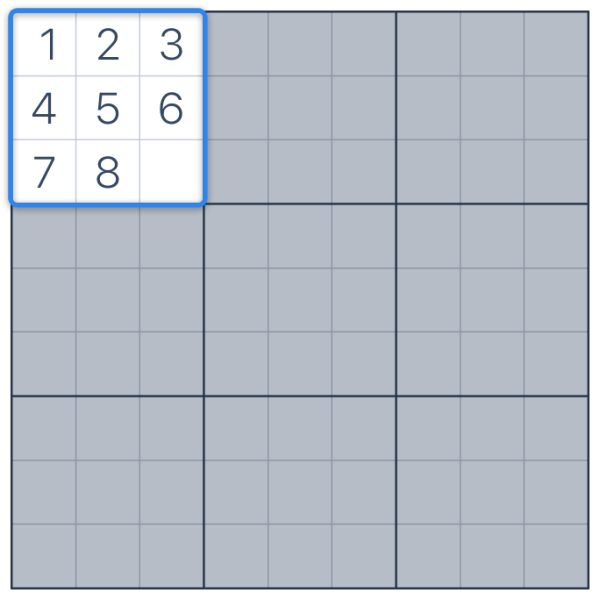

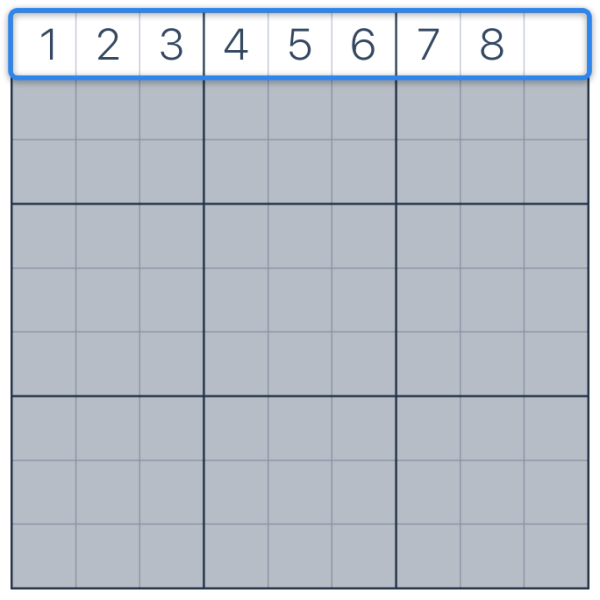
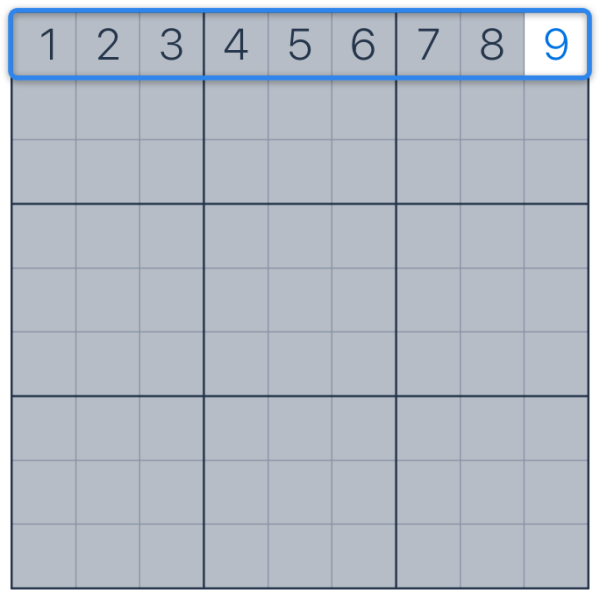
"Last remaining cell" technique.
"Last remaining cell" is another basic Sudoku strategy. It's based on the fact that numbers should not be repeated within 3×3 block, vertical column and horizontal row.
Let's take a look at an example with the 3x3 block. There always must be number 8 - in each block, column and row. There's already 8 in the column and in the row. As we already know, we can't repeat numbers. So we can't place 8 there again. It means that there's only one cell remaining inside the block and we should put number 8 into it.
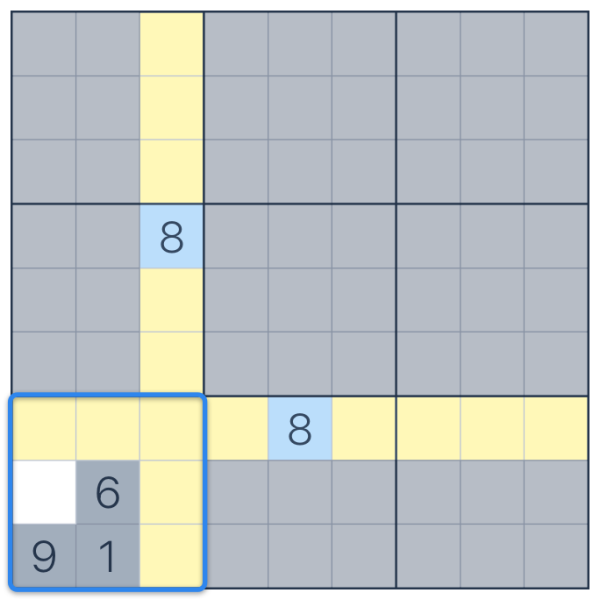
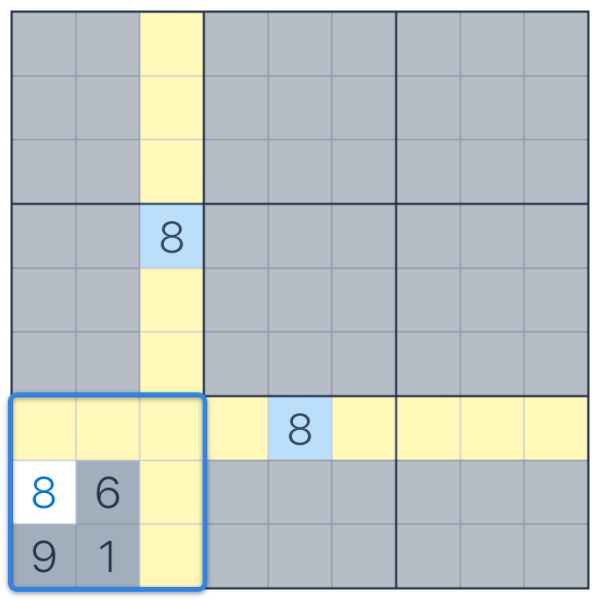
The same technique applies to the Rows and Columns.
"Last possible number" technique.
Last possible number is a simple strategy that is suitable for beginners. It is based on finding the missing number. To find the missing number you should take a look at the numbers that are already exist in the 3x3 block you are interested in, and in the rows and columns connected with it.
Let's take a look at an example.
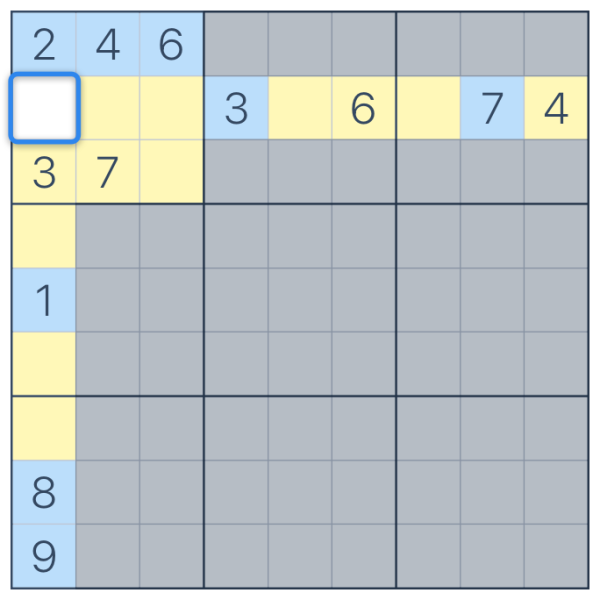
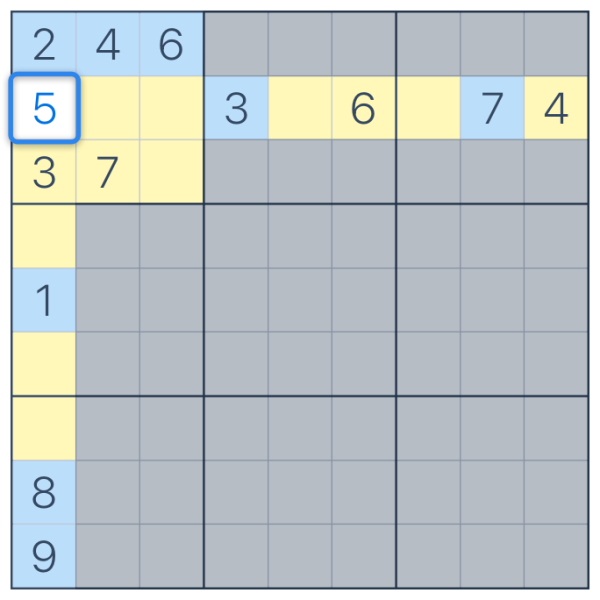
Pay attention to the highlighted cell. Look at the numbers in its block, row and column. We can see that numbers 1,2,3,4,6,7,8,9 are already used in this row, column and block.
The only missing number is 5. Considering that numbers should not be repeated, the only number that must be put in this cell is 5.
That is how "Last possible number" technique works. Once you have mastered it, you will begin to solve Sudoku easier and faster!
"Obvious singles" technique.
This strategy is based on the correct placement of Notes. Sometimes it is called Naked Singles. The point is that in a specific cell only one digit (from the Notes) remains possible.
Let's have look at this case with an example.

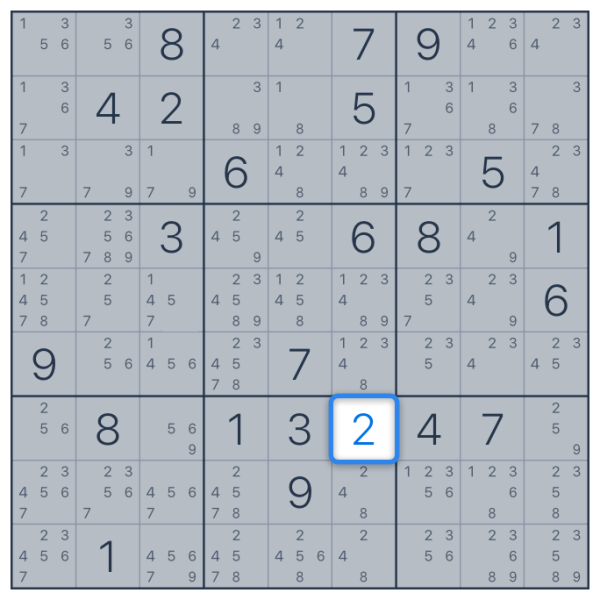
Let's look at the highlighted cell. We can see that it is filled with only one Note - number 2. It means that this cell has only one possible solution. Since it is the only possible option, this cell will be 2. So we remove Note from this cell and fill it with the number 2.
That is how "Obvious singles" technique works. As you see, this is not as difficult as it seems. Therefore, if you put "Obvious singles" technique into practice, the process of solving Sudoku will become easier and faster!
"Obvious pairs" technique.
Like the "Obvious Singles" technique, "Obvious pairs" is based on the correct placement of Notes. The point is that you should find 2 cells with the same pairs of Notes within 3x3 block. This means that these pairs of Notes cannot be used in other cells within this 3x3 block. So they can be removed from your Notes. It will be easier to understand this strategy if you look at the example.
Let's look at this block. We see empty cells filled with notes of possible numbers. Among them, there are two cells that contain 7 or 9.
This means that one of these cells necessarily contains 7 and the other one contains 9. This also means that we can't have 7 and 9 in other cells of this block.
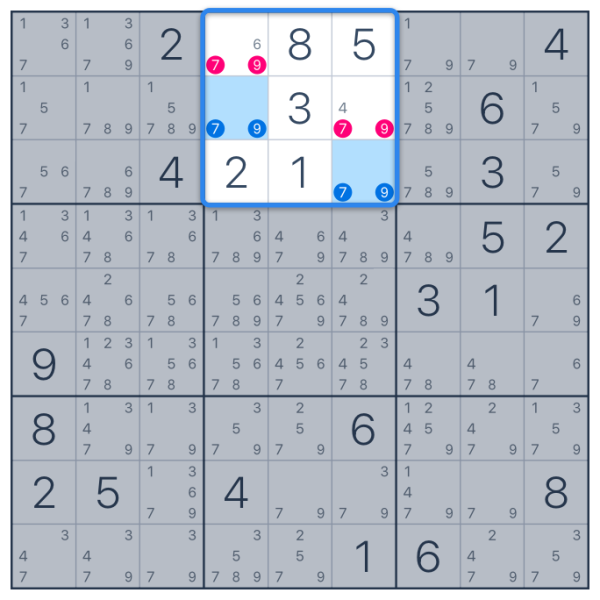
Hence, we remove them from other cells' notes. Next we can apply the "Obvious singles" rule we learned in the previous lesson. We'll write 6 in the cell with a single note of 6 and and 4 in another one.
That is how "Obvious Pairs" technique can be used while solving Sudoku. Once you have learned it, you can proceed with the following Sudoku strategies.
What are the basic rules of Sudoku?
Sudoku grid consists of 9x9 spaces.
You can use only numbers from 1 to 9.
Each 3×3 block can only contain numbers from 1 to 9.
Each vertical column can only contain numbers from 1 to 9.
Each horizontal row can only contain numbers from 1 to 9.
Each number in the 3×3 block, vertical column or horizontal row can be used only once.
The game is over when the whole Sudoku grid is correctly filled with numbers.
How to play Sudoku
The goal of Sudoku is to fill in a 9×9 grid with digits so that each column, row, and 3×3 section contain the numbers between 1 to 9. At the beginning of the game, the 9×9 grid will have some of the squares filled in. Your job is to use logic to fill in the missing digits and complete the grid. Don’t forget, a move is incorrect if:
Any row contains more than one of the same number from 1 to 9
Any column contains more than one of the same number from 1 to 9
Any 3×3 grid contains more than one of the same number from 1 to 9
Sudoku Tips and Tricks That’ll Help You Solve Faster
1) Know where to start solving
If you’re new to playing Sudoku, you might find you don’t know where to start whenever you first look at a new puzzle.
Sometimes placing the first digit in the grid can be the hardest part.
To make it easier, there are certain things you’ll want to look for. There are also certain things you don’t want to do.
The first tip is to look for rows, columns or the 3×3 blocks where there are more given digits.
These areas with more given digits will constrain the other empty cells within the same row, column or block. Meaning that there’ll be fewer possibilities for what values these cells can contain than for other empty cells.
Related to this, another trick is to look at which numbers appear more among the given digits.
For example, if you have a new Sudoku puzzle with five 9s already given and no 2s, then placing one of the four remaining 9s into the grid will usually be easier than placing one of the nine 2s.
2) Look for single candidates
Single candidates, also known as naked singles, occur when a particular cell can only has one possible candidate.
This will be because all the other digits from 1 to 9 will have been ruled out by other numbers in the grid.
If you look at the Sudoku puzzle below, you’ll notice that cell row 7, column 5 only has a single candidate – 1.
This is because all the other numbers from 2 to 9 appear in either the same row, column or in the 3×3 block.
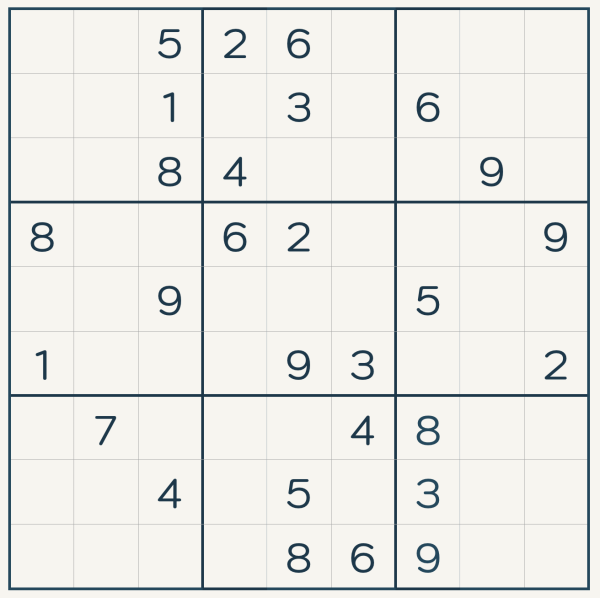
This also shows the importance of the previous tip of starting in areas with plenty of given digits.
3) Work on your scanning techniques
Don’t try to focus on the entire Sudoku grid at the one time.
Instead, it’s better to scan different rows, columns and 3×3 blocks one at a time. This way you’ll be able to identify which areas are easier so that you can tackle them first.
Taking this tip a step further, when you feel confident, you’ll also want to scan a couple of areas at the one time to see how they interact.
For example, if you scan along a row and a column and notice that together they contain a large number of digits, then you’ll immediately know that the cell where they intersect will be heavily constrained.
4) Don’t focus too long in the one place
Effective scanning also means that you don’t spend too long looking at one part of the grid.
If you’re doing this, then it likely means that the part of the grid you’re focusing on requires you to place digits elsewhere in the grid before you can resolve it.
That’s why it’s important to learn how to shift your focus around the grid to identify which area can be worked on first. Then you can come back to the more difficult areas later.
5) Keep the momentum going
Because some areas of the grid will require you place other digits elsewhere first before they can be resolved, it makes Sudoku a puzzle of momentum.
Once you start placing digits in the grid, it will become apparent that you can resolve other empty cells almost in a cascading manner.
This is why it’s important to scan along rows, columns and within the 3×3 blocks whenever you place a new digit as that might unlock new cells.
6) Make use of pencil marking
Pencil marking possible candidates into empty cells will help work your way through Sudoku puzzles through the process of elimination.
When done right, pencil marking will also help refine your scanning techniques and identify naked pairs as well as hidden pairs (both covered below).
7) Look for naked pairs
A naked pair is when two empty cells can only contain the exact same two possible candidates.
An example of a naked pair has been highlighted in the Sudoku below.
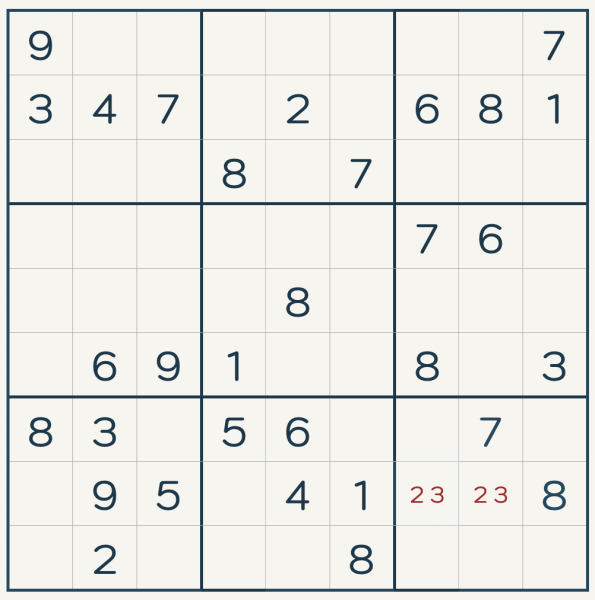
Because these two empty cells in row 8 can only contain either a 2 or a 3, it immediately rules 2s and 3s out of the remaining empty cells in both the 3×3 block and the entire row.
This is because, regardless of which one is which, there is no possible way you can place a 2 or a 3 elsewhere in the box or row.
Identifying naked pairs like this can be very useful as it can restrict the cells around them to the point of revealing a new digit to place.
In this particular example, the cell in column 4, row 8 is now restricted enough that it can only contain a 7.

While we still don’t know which way the 2 and the 3 should be placed, by identifying the naked pair, we’ve successfully placed a new digit in the grid.
Building on this momentum, the first cell in the row must now be a 6 so that row 8 contains all the digits from 1 to 9.
8) Look for hidden pairs
Related to the concept of naked pairs is the idea of hidden pairs.
The difference between a pair being naked or hidden is whether the pair is the only two possible candidates or not.
If in the example above there was no 7 in the bottom right box, then there would be no naked pair, but we would still be able to place the 6 in the first cell of the grid.
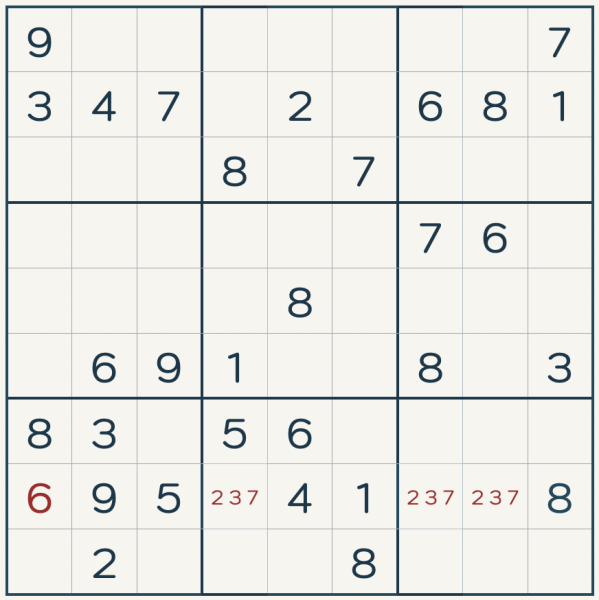
9) Work your way through more advanced Sudoku strategies
As you work your way up from easiest levels to the hardest levels, you’ll have to new and deploy new and increasingly advanced Sudoku strategies.
While pencil marking and X-wings are fairly basic strategies, the harder the puzzles get, the more complicated the strategies you’ll have to learn.
This is part of the fun of cracking Sudokus where you get to expand your solving skill set.
If you find yourself stuck on a particularly challenging Sudoku, it might also be worth entering it into a Sudoku solver. While you may not want them to solve the Sudoku for you, many will tell you what strategies are required to solve your puzzle.
10) Don’t guess – use the process of elimination
Our last Sudoku tip is simple: Remember that Sudoku is a puzzle of logical deduction that uses the process of elimination to arrive at an unique solution.
That means you never have to guess when solving a Sudoku.
Remain patient and think about the puzzle in front of you logically and carefully all while keeping the Sudoku hints and tips above in mind.
Features include hints, auto-check, and the ability to highlight duplicates, making it easier to complete each puzzle. The app offers six difficulty levels, from easy to giant, ensuring there's a challenge for everyone. You can track your progress, undo mistakes, choose color themes, and even make notes on the grid.
With daily challenges, seasonal events, and unique trophies and medals to win, Sudoku Free Puzzle offers a rewarding gaming experience. The app also supports both phones and tablets, allowing you to play in portrait or landscape mode.
Start your day right with a few rounds of Sudoku Free Puzzle to get your brain in gear. With regular practice, you'll soon become a Sudoku master, capable of tackling even the toughest puzzles with ease. Download the app now and enjoy hours of offline Sudoku fun.
- Version6.14.0
- UpdateSep 19, 2024
- DeveloperEasybrain
- CategoryCasual & Puzzle
- Requires AndroidAndroid 7.0+
- Downloads46M+
- Package Namecom.easybrain.sudoku.android
- Signature1dfd0653646aff776b8a88d2f20c244a
- Available on
- ReportFlag as inappropriate
-
NameSizeDownload
-
152.00 MB
-
150.16 MB
-
148.25 MB



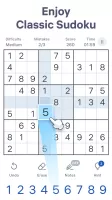
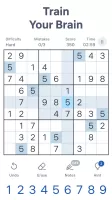

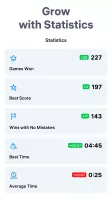
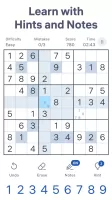
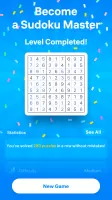
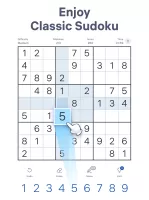

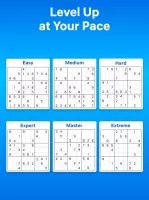

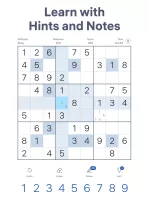

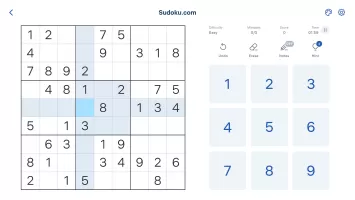

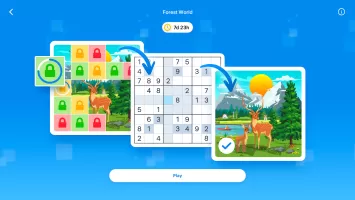
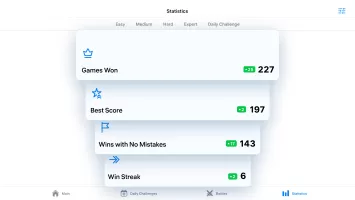
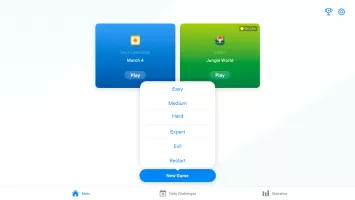
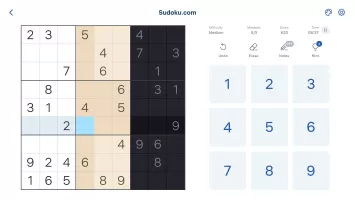
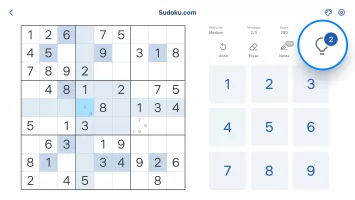
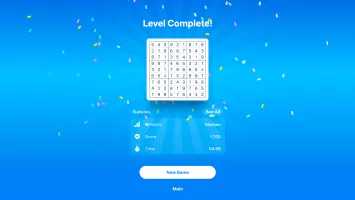
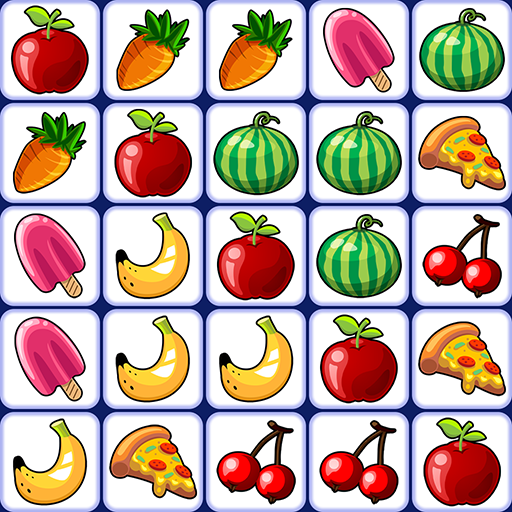


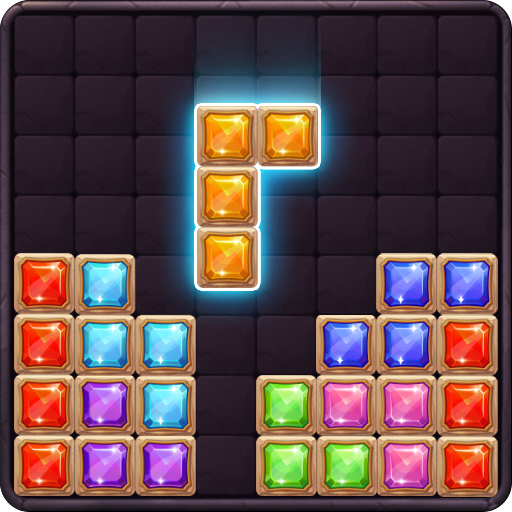



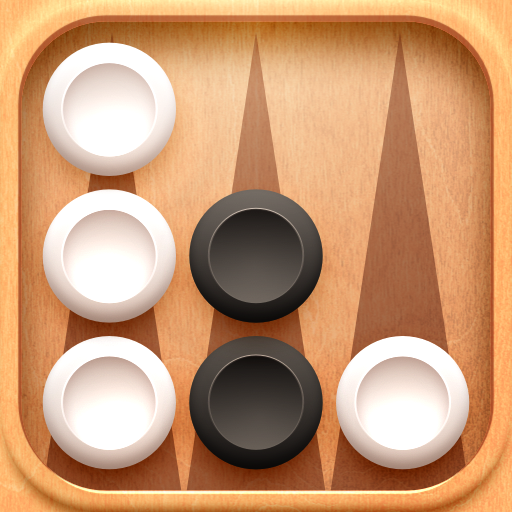









Provides multiple difficulty levels from beginners to advanced players
Provides hints and auto-check functions to help players better understand the rules and improve skills
Supports offline play
Free version has frequent pop-up ads
Lacks the ability to interact with other players